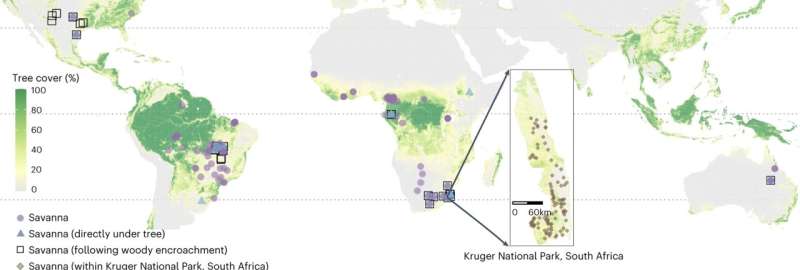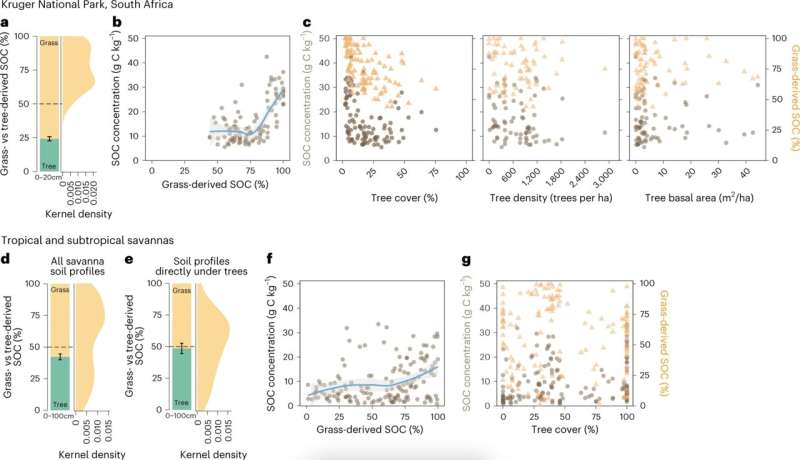August 29, 2023 feature
This article has been reviewed according to Science X's editorial process and policies. Editors have highlighted the following attributes while ensuring the content's credibility:
fact-checked
peer-reviewed publication
trusted source
proofread
Afforestation carbon sequestration projects found to be less effective than grasses in tropical savannas

Global warming's ever-increasing toll on the planet has been a focus of mitigation strategies in recent years, with carbon sequestration projects playing a more prominent role in drawing carbon dioxide out of the atmosphere to store in solid or liquid form and therefore decrease the abundance of this greenhouse gas. By doing so, this reduces the trapping of solar radiation on Earth and thus aids a decline in the planet's temperature.
One such carbon sequestration project has targeted tropical savannas and used the planting of trees (known as afforestation) to remove carbon dioxide from the atmosphere for storage in woody biomass of the growing tree and the soil as organic carbon. The former above-ground carbon storage is known to be effective, but that of underground carbon storage in soils is less well understood.
Measuring the success of this project remains challenging as grasses also produce soil organic carbon, and new research published in Nature Geoscience aims to uncouple the two so that the efficiency and expansion of afforestation carbon sequestration projects can be determined.
Dr. Yong Zhou, Assistant Professor at Utah State University, U.S., and colleagues investigated such a project in Kruger National Park, South Africa, alongside a host of global tropical savannas.
The researchers discovered that grasses contribute over half of the soil organic carbon down to a depth of 1m, and this was still the case for soils directly below trees. Soil organic carbon also varied positively and negatively with increasing tree cover, having a maximum 6% increase, therefore highlighting that afforestation may not be as effective at carbon sequestration as initially hoped, especially when compared to grasses.
Despite this, trees may have a somewhat symbiotic effect in increasing grass productivity in arid and semi-arid savannas (experiencing less than 700mm of rainfall annually), which affects the overall carbon storage of the system. Conversely, in mesic savannas (over 700mm rainfall annually) the effect of tree cover on grass productivity is negative, thus leading to a decline in overall soil organic carbon.

Another factor affecting carbon storage in the ground is the type of soil; clay-rich soils have a higher capacity for carbon storage than sandier substrates. Yet, the latter allows for greater drainage and enables woodier vegetation to grow, which aids carbon storage in biomass above ground.
The researchers conducted analyses on the type of carbon stored (based upon isotopes of carbon, the same element with different atomic masses) which are produced by different photosynthesis pathways: C4 for grasses and C3 for trees. By doing so, they could determine which was the primary source for the carbon stored within the test soils. This was then combined with 148 soil profiles from global tropical and subtropical savannas to generate an overview of the contribution of grasses versus tress across varying rainfall and tree cover gradients.
Across Kruger National Park, 98 soil samples were taken and analyses revealed that 76% of the soil organic carbon was derived from grasses, while over all tropical regions this was 57%, and still at 51% grass-origin directly underneath trees. For Kruger, the researchers identified a distinct positive correlation between soil organic carbon and grass biomass, but a negative response to increasing sand content.
In comparison, grasses are better adapted to obtaining water and nutrients from clay-rich soils over trees (which accounts for just 24% of carbon in the park). Looking more globally, South American savannas had the lowest soil organic carbon compared to those in Africa and Australia, which the researchers attribute to nutrient deficiency inhibiting substantial grass growth. Additionally, the higher rainfall in South America may encourage denser tree canopy growth, with the subsequent shade at ground level impeding significant grass development, and therefore carbon storage. Instead, carbon storage in tree biomass dominates here.
Nevertheless, the research team calculated that afforestation in grassy ecosystems increased soil organic carbon by 5.74 megagrams of carbon per hectare. This was most significant in the upper 30cm of the 1m soil profiles analyzed.
Given that much of this organic carbon is concentrated in the surface layer, there is risk that it may be released back into the atmosphere during forest fires that scorch the ground, and are becoming an increasingly frequent occurrence each summer.
Therefore, the suggested approach is to rely upon grasses as the major driver of carbon sequestration in savannas and reconsider the incremental gains of afforestation projects. While these do have some positive effects on increasing grass productivity for storage of more carbon at greater depth away from potential bush/forest fires as tree roots extend deeper, it may not be sufficient to outweigh the costs to water resources management and biodiversity in their growth.
Further work needs to be conducted on determining the effect of different grass types on soil carbon sequestration, clay content and minerals, the age of tree biomass, as well as the action of herbivores grazing in the area.
More information: Yong Zhou et al, Soil carbon in tropical savannas mostly derived from grasses, Nature Geoscience (2023). DOI: 10.1038/s41561-023-01232-0.
Journal information: Nature Geoscience
© 2023 Science X Network




















